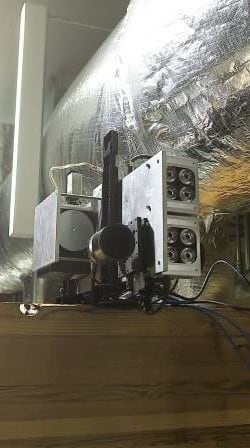Sometimes it seems like there's not enough bug spray in the world to keep those pesky bloodsuckers away, and it can be more than just an annoyance.
With mosquito-transmitted diseases like malaria and Zika, a bite could have dire consequences.
A new product being developed and tested aims to zap mosquitoes out of the air before they have a chance to infect humans.
The Photonic Fence was created through the Global Good program — a collaboration between Bill Gates and Intellectual Ventures that tries to fill the gaps between technology and what people need.
"We have existing solutions for things like malaria, but they don't really work," said Arty Makagon, technical project lead at Intellectual Ventures.
Makagon referenced how bed nets treated with insecticide are used across the world to protect people from malaria, but mosquitoes have adapted.
When the pests realized they weren't getting their blood meals at night — their main biting time — they started going after humans during the day. The once-nocturnal mosquitoes also developed resistance to the insecticides used on the nets.
With the Photonic Fence, if a malaria-carrying mosquito flew within the device's range, a laser would shoot it down.
"With [this product], the neat thing is you can't develop resistance," Makagon said.
The team is hoping to deploy the device at forward operating bases and field hospitals in order to keep troops safe from mosquito-borne diseases.
Intellectual Ventures presented the military applications of the Photonic Fence during the Association of the United States Army's Army Medical Hot Topic Forum on Sept. 22. The company has spoken with groups across the Defense Department and it is looking for partners specifically interested in conducting field trials in a military setting.

Each box is able to deliver 10 kills per second -- the more boxes, the more kills.
Photo Credit: Courtesy of Intellectual Ventures
How it works
The mosquito zapper has three subsystems: tracking, lethal and safety.
The virtual fence uses an optical system with lenses and cameras to track what's flying by — the goal is to take out the "bad bugs" like mosquitoes but not the good guys like bumblebees.
Makagon said the tracking system gathers data about each potential target, including the time of day it showed up and its size, shape and speed.
"If it's a bad bug, we engage the lethal laser," he said.
The fiber laser uses photonic energy to kill the mosquito. The process of identifying and eliminating the target takes about 100 milliseconds, according to Makagon.
The laser itself is outside of the human visible range, which means it wouldn't cause any damage if it happened to point at a person's eye, he said.
With an operational range of 100 meters, each Photonic Fence box can issue 10 kills per second — the more boxes there are, the more mosquitoes it can kill.
How to use it
"The idea is to fence a particular area and keep the bug out but also as they're flying back and forth," said Jeremy Salesin, vice president of acquisitions for Intellectual Ventures.
The main idea is to use the fence around forward operating bases and field medical clinics in developing countries where mosquito-borne diseases are prevalent, Salesin said, but they're also looking at deploying the boxes in agricultural settings and resorts.
Salesin said the technology can be upgraded in real time, as well.
"You may see [insects] you don't recognize that can't be recorded back to the network [and identified]," he said. "The base station operator can figure out what that is and if it should be added to the list [of bugs to kill]."
Since the creators see the Photonic Fence mostly being used in areas that are off the grid, they use solar cells to power it.
"The safety system and lethal system are down in the weeds when it comes to energy consumption," Makagon said.
The tracking system needs the most energy since it requires light to see through the optics, he said, but the team was pleasantly surprised to find out it takes less than 100 millijoules — not much energy at all.
The next step
Intellectual Ventures plans to start field testing in early 2017, with the primary testing location at the Department of Agriculture's research laboratory in Florida.
"We're looking for more partners who want to help us with either development dollars or expertise or location where we can test the units," Salesin said.
The team is especially interested in military installations or field hospitals that are interested in being a test site, he said.
Although the main goal of the Photonic Fence is to stop the spread of disease, another benefit is for entomologists, or people who study insects.
"As much as we love killing bugs, entomologists are really interested in bug behavior," Makagon said.
The Photonic Fence doesn't affect the insect's behavior while being monitored, Salesin said, unlike traps that might use chemicals. It also does what bug spray does not.
"It catalogs everything it sees and transmits that information back to the guys in the lab who are trying to figure out better solutions," Makagon said. "What we can do is feed a bunch of that data back to the scientific community to design better tools."
Charlsy Panzino covers the Army and Air Force. Email her at cpanzino@militarytimes.com.
Charlsy is a Reporter and Engagement Manager for Military Times. Email her at cpanzino@militarytimes.com.





